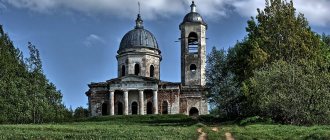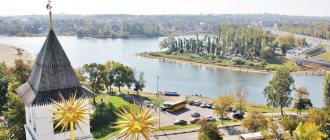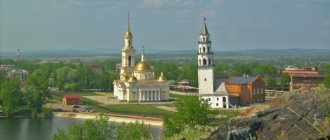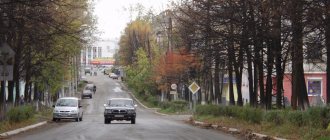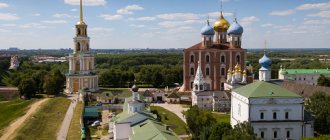Shigir pantry
The oldest wooden sculpture on Earth from the Urals.
The Museum of History and Archeology of the Middle Urals houses one of the most unique finds not only in the Sverdlovsk region, but throughout the world. As part of the “Shigir Pantry” exhibition, you will see the Great Shigir Idol – the largest and oldest monumental cult sculpture made of wood on Earth.
The idol, according to scientists, is from 9,500 to 11,000 years old, which means that it is almost 3 times older than the pyramids in Egypt and the mummies of the pharaohs! The then inhabitants of the Ural land made a sculpture from a split larch trunk, and at that time it was a figure 5.3 meters high. Researchers believe that the idol depicts the mythology of the ancient Urals.
- Where and when: Museum of History and Archeology of the Middle Urals, Yekaterinburg, prosp. Lenina, 69/10. See opening hours and ticket prices here.
To Konzhakovsky Stone by car
Mount Konzhakovsky Stone, located in the southern part of the Northern Urals, on the territory of the Sverdlovsk region, is one of the highest and most interesting peaks of the Ural range.
Dunite deposits found at the foot of the mountain, on the territory of the Job Plateau, laid the foundation for the development of a quarry, and as a result, the construction of a road for transporting the extracted material.
Actually, the presence of a road that is not yet closed to ordinary tourists made it possible to carry out a road trip almost to the foot of the Konzhakovsky stone.
The route is designed for SUVs; Nissan X-Trail and Toyota RAV 4 were spotted at the foot of the mountain. The distance from Yekaterinburg to the top of the Konzhakovsky Stone is 475 km, incl. walk about 4.5 km. from the parking lot, on the Job plateau, to the top of the mountain.
Lake Shartash
A body of water a million years old.
The lakes of the Sverdlovsk region are almost the most popular natural attractions, and this is not surprising. Thus, within the boundaries of Yekaterinburg there is a unique lake that was formed more than a million years ago. People have inhabited the area around a small reservoir, shaped like a bean, since the Paleolithic (by the way, near the lake you can find the remains of ancient settlements, which are called the Shartash “megaliths”).
Since then, the flora and fauna around have changed: now instead of ferns there are coniferous forests, instead of lizards there are bears, moose, and wolves. And only the shape of the lake remained the same. Today it is considered the main natural attraction of Yekaterinburg - residents of Yekaterinburg consider a holiday on Shartash at any time of the year an excellent way to spend a weekend with their family.
- Where and when: Shartash can be visited all year round - in summer for sunbathing and swimming, in winter for skiing and ice fishing. The lake is located in the Kirovsky district of Yekaterinburg, on the northeastern outskirts of the city.
Nizhnyaya Sinyachikha
A museum created by a simple Ural citizen.
In the village of Nizhnyaya Sinyachikha there is a unique museum-reserve of wooden architecture, which was created entirely through the efforts of a local resident. In the 70s of the last century, Ivan Danilovich Samoilov decided to restore a crumbling ancient wooden church in the village - so he came up with the idea of collecting the best examples of Russian wooden architecture in this place.
Soon the enthusiast began to travel around the villages of the Sverdlovsk region and collect future exhibits (houses, towers, mills, chapels) - they were dismantled, transported to Nizhnyaya Sinyachikha, carefully assembled and restored. Carefully restored and protected objects of wooden architecture are definitely worth the attention of both local residents and tourists.
- Where and when: the museum-reserve is located 160 km from Yekaterinburg. See opening hours and ticket prices here.
Threshold Howler
The roar of the Ural river.
It so happens that the rivers in the Middle Urals do not have rapids. The calm and quiet Ural River Iset, which flows in the center of Yekaterinburg, 80 kilometers from the regional capital, changes beyond recognition and turns into a frantic water flow among the rocks - an ideal place for fans of extreme rafting.
Thanks to the boulders blocking the path, the water makes such powerful sounds that they can be heard several hundred meters away. That's why this place was nicknamed Howler. By the way, scenes from the famous Russian film “The Geographer Drank the Globe Away” were filmed here, right on the doorstep.
- Where and when: Tourists and locals visit Revun Rapids all year round, but the most popular time to visit is late spring and early summer. The place is located 80 km from Yekaterinburg, in the Kamensky district of the Sverdlovsk region;
- Tip: in one day you can visit not only the Revun rapids, but also the Smolinskaya cave, which is located very close (read about it below).
Mount Mare's Head, Kyrman Rocks
The route to one of the interesting mountains of the Sverdlovsk region - Mount Kobylya Golova and the Kyrman Rocks - is ideal as a weekend hike for the whole family.
The mountains are easily accessible to unprepared tourists: the tops of the rocky outcrops of the mountains are easy to climb. The route is designed for all-terrain vehicles, but is also suitable for ordinary passenger cars. In this case, you can leave your car just outside the village of Ayat and walk. From Ayati to the rocks it is about 5 kilometers. The distance from Yekaterinburg to the Kyrman Rocks is about 60 km.
Smolinskaya cave
Chapel of the Ural Old Believers.
At a distance of only 1 km from the Revun rapids there is another interesting place that was discovered by scientists at the end of the 19th century. In the cave, more than 800 meters long, which was named after the nearby village of Smolino, icons, steps carved into the rock and benches were found.
It is still unknown at what time the Ural Old Believers chose this place and how often they gathered here for services, however, the Smolinskaya cave with grottoes called “Big Cell”, “Altar”, “Road to Hell” is visited to this day. True, already for tourism purposes.
- Where and when: I recommend visiting the cave in the dry season and accompanied by a guide. The place is located 80 km from Yekaterinburg, in the Kamensky district of the Sverdlovsk region.
Waterfall on the Shata River
A weekend route to a waterfall on the Shata River - one of the interesting and few waterfalls in the Sverdlovsk region.
The total height of the rapids of the Shata waterfall is about five meters. The waterfall is located on the small river Shata, flowing through the village of the same name.
In the vicinity of the waterfall there are clearings where you can have a picnic; it is also suitable for families with children.
The weekend route is designed for standard passenger cars. The distance from Yekaterinburg to the Shata waterfall is about 115 km.
Stone gate
A unique natural monument.
Very close to the Revun threshold and the Smolinskaya cave there is another stunningly beautiful place - the most beautiful and unusual 20-meter rock on the Iset River called “Stone Gate”.
Right in its center, due to the destruction of the rock, an arch was formed, which makes this natural object so unique. By the way, if you look closely, you can see ancient fossils in the rock.
- Where and when: the rock can be visited all year round; it is located about 30 km from the Revun rapids and the Smolinskaya cave, 97 km from Yekaterinburg and 9 km from Kamensk-Uralsky.
Talkov Stone
New life for an old mine.
Despite its name, Talkov Stone is another of the picturesque lakes in the Sverdlovsk region. Only now it was created by the joint efforts of man and nature.
Once upon a time, talc was mined at this place, not far from the city of Sysert, but in the 20th century this mineral lost its relevance, and work on its extraction was completely stopped. After some time, the mine was flooded with water.
Today it is a wonderful place for relaxation, walking, and also for training scuba divers and divers - despite its modest dimensions (about 70 meters wide), the depth of the reservoir reaches more than 30 meters.
- Where and when: the lake can be visited all year round; it is located approximately 9 km from Sysert and 53 km from Yekaterinburg.
Sverdlovsk region
The Sverdlovsk region, according to official data, includes 47 cities, including the millionaire city of Yekaterinburg, one large city - Nizhny Tagil, two large ones - Kamensk-Uralsky and Pervouralsk, 30 medium-sized cities and 13 small ones. Cities that are interesting for tourism are administrative and regional centers. Most of the Ural cities grew out of workers' settlements at metallurgical plants, this is manifested in their layout and architecture, as well as in the features of attractions. But every Ural city or village, regardless of size, has its own rich history, albeit few, but often unique attractions.
Ekaterinburg
Yekaterinburg is the administrative center of the Sverdlovsk region, relatively young, it is only approaching its 300th anniversary, but it is a city with a rich history, its foundation is associated with the names of the associates of Peter I - V.N. Tatishchev and G.V. de Genin.
Administration of the city of Yekaterinburg
© Vasja
In 1723, by decree of Peter I, construction of the largest ironworks in Russia began on the banks of the Iset River. Currently, it is the fourth most populous city in Russia, one of the most important industrial, financial and cultural centers of the country.
Yekaterinburg has many attractions of various kinds - architectural, historical, cultural; There are historical and cultural monuments here that are considered a national treasure; everyone can find something new and interesting for themselves.
Are you here for a short time and want to see as much as possible? Take the Yekaterinburg Red Line, connecting 35 attractions in the city's historic center.
Everyone knows that there is a sad page in the history of Yekaterinburg - the tragic death of the family of the last Russian Emperor Nicholas II. Is it interesting for you? Follow the blue line - a route connecting places associated with the name of the royal family.
Temple on blood
© Anna Kudryavtseva
Do you love architecture? Do you know that Yekaterinburg is considered the capital of constructivism, an architectural style born at the dawn of the era of socialism? Nowhere else are there so many masterpieces of the style popular in the 1920s and 1930s.
Do you want to see the unique Kasli cast-iron pavilion, which received an award at the World Exhibition in Paris in 1900, or magnificent works of stone-cutting art by Ural craftsmen? Ekaterinburg museums await you, more than fifty of them with a wide variety of collections.
Do you like theater? Yekaterinburg is one of the largest theater centers in Russia; it ranks third in the country in terms of the number of theaters.
The city has opportunities for religious tourism , with monasteries and temples of different faiths.
You can come to Yekaterinburg at any time of the year; a long winter is not a hindrance. On New Year's holidays, an Ice Town with attractions and ice sculptures is built on the main city square. On Christmas days, the Star of Bethlehem ice sculpture festival takes place at the Church on the Blood. You can also practice winter sports at the ski resort on Mount Uktus within the city.
Guide to Ekaterinburg Stories and reviews from tourists
Upper Pyshma
Verkhnyaya Pyshma is the copper capital of the Urals, a satellite city of Yekaterinburg. The history of the city began in 1854, when copper ore mining began at the headwaters of the Pyshma River. Then the village of Copper Rudnik was founded, and two years later a small copper smelter appeared next to the mine. The village received a new impetus for development during the period of industrialization, when the construction of a new copper-electrolyte plant began, which produced copper in 1934.
In 1946, the workers' settlement was transformed into a city, which was given the name Verkhnyaya Pyshma. As of 2022, the city's population is 70,160 people, and the population is gradually but steadily growing. The basis of the city's economy is made up of non-ferrous metallurgy and mechanical engineering enterprises. The largest holding company is based here - OJSC "UMMC-Holding" (Ural Mining and Metallurgical Company), which united many enterprises of the "copper industry" into a single technological chain from the extraction of raw materials to metal production. The second well-known enterprise in the city is the one built in the early 2000s, which produces electric locomotives and Lastochka electric trains.
UMMC Museum and residential high-rise buildings
© Anna Kudryavtseva
Until the 1930s, Verkhnyaya Pyshma was a small village near a copper mine, so there is nothing historical in the city: standard typical post-war buildings, a significant private sector, high-rise buildings of recent years.
All the most interesting things for tourists in the city have been created in recent years and are located compactly: this is the UMMC Park, the Memorial to the Victims of Political Repression, the Monument to the Miner, and the Memorial to those killed in the Great Patriotic War.
The city has three religious attractions: the beautiful Orthodox Church of the Assumption of the Virgin Mary and a small temple in the name of the Holy Prince Alexander Nevsky, as well as the main mosque of Sverdlovsk Muslims - the cathedral mosque of Imam Ismail Al Bukhari, more often called “Copper”.
But the most famous attraction of Verkhnyaya Pyshma, which attracts tourists from different cities, are two museums belonging to UMMC: the Military Glory of the Urals Museum of Military Equipment and the 20th Century AUTO Museum of Automotive Equipment.
Information about Verkhnyaya Pyshma Stories and reviews from tourists
Berezovsky
Berezovsky is the second largest satellite city of Yekaterinburg, located 12 kilometers to the northeast. A small, very green city with a population of about 60 thousand people.
What is this city famous for? Berezovsky is considered the birthplace of Russian gold.
Victory Park in Berezovsky
© Anna Kudryavtseva
In these places in 1745, a resident of the village of Shartash, Erofei Markov, found pieces of quartz interspersed with gold, which he duly reported to the mining authorities. This message was met with disbelief, but a search was organized at the place indicated by Markov. The search did not yield any results, not even signs of gold were found. Erofey Markov was put under arrest, accused of concealing the real deposit. Gold was finally found a couple of years later, and it was a great historical event, since the deposit was the first on Russian territory.
In 1948, a gold mine was founded and this year is considered the year Berezovsky was founded.
It is quite clear that the main attractions of the city are associated with gold. There is a Gold Museum here, where you can learn about the history of local mines, the process of gold mining and gold, where it is mined, why and in what quantity.
In addition, in Berezovsky there is an interactive Mine Museum, where you have a unique opportunity to go down into a real mine and try yourself as a prospector, panning for gold-bearing sands.
Information about Berezovsky Stories and reviews from tourists
Nizhny Tagil
Nizhny Tagil is the second largest city in the Sverdlovsk region, which is located 143 kilometers from the regional center. The city's population as of 2022 is 353,950 people.
City view
© Anna Kudryavtseva
Nizhny Tagil is a hard-working Ural city; for almost three centuries the best grades of steel and cast iron have been produced here, railway cars and military equipment have been built, and unique cast and forged products have been produced.
The emergence of the city is associated with the beginning of the development of a magnetic iron ore deposit on Mount Vysokaya in 1721 and the construction of the Vyysky and Tagil ironworks by Nikita and Akinfiy Demidov.
Officially, the founding date of Nizhny Tagil is considered to be 1722, when the first product, cast iron, was produced at the Vyysky plant.
If you like to travel around Russian cities, then you won’t be bored in Nizhny Tagil. This is a city with an interesting history and unusual sights, where people were born that Russia is proud of.
It’s easier to start getting acquainted with the city from the Malachite Line - a pedestrian route marked with a green stripe on the asphalt and connecting historical, cultural and architectural sites of the past and present. Here you will learn a lot of interesting things!
Fox Mountain
© Anna Kudryavtseva
You definitely need to climb Fox Mountain; it is an excellent observation deck, from where you can clearly see the entire city and the Nizhny Tagil pond. Believe me, you will be amazed by the industrial landscape that opens from there!
Nearby is the most monumental landmark of Nizhny Tagil - a metallurgical plant that produced products for two and a half centuries, and at the end of the 20th century became a museum. This plant-museum is unique in that three centuries of domestic metallurgy “meet” here.
Do you know that Nizhny Tagil is the birthplace of lacquer tray painting? It is believed that Tagil painting is the predecessor of Zhostovo painting; it is more than 250 years old. In Nizhny Tagil there is the “Museum of the History of Tray Craft”, the Historical and Technical Museum “House of Cherepanovs”, the “Museum of the History of Uralvagon” and many others.
Information about Nizhny Tagil Stories and reviews from tourists
Kamensk-Uralsky
In the Sverdlovsk region there is a city through which the border of the Urals and Siberia passes. This is the third largest and southernmost city in the region - Kamensk-Uralsky, included in the list of historical cities of Russia. There are many attractions here, there are both cultural and natural monuments - the magnificently beautiful banks of the Iset with numerous rocks, caves, and suspension bridges.
The settlement on this site was founded in 1682, when iron ore was found on the banks of the Kamenka and Iset. The city managed to preserve the appearance that developed in the 18th–19th centuries. The old part of the city is its historical landmark.
Administration building of the state-owned iron foundry
© Igor Butyrskii
The city has a rich history. In 1701, by decree of Peter I, they began to build an ironworks here, the first iron foundry in the Urals. It worked for 225 years and was closed only in 1926.
In January 1774, a settlement near the plant, which was called Kamensky Zavod, found itself in the zone of a major peasant uprising led by Emelyan Pugachev.
The plant was captured, and Kamensk craftsmen had to cast cannons and cannonballs for the Pugachevites.
The factory village was officially given city status in 1935; it began to be called Kamensky-Uralsky five years later. The population for 2022 is 168,997 people. Now it is a large industrial and cultural center of the Middle Urals. Here are such large enterprises as the Sinarsky Pipe Plant and the Kamensk-Ural Metallurgical Plant, which produces products from aluminum and magnesium alloys.
Kamensk-Uralsky is called the bell capital of Russia. There is a large specialized bell production facility here, and since 2005 the All-Russian Bell Ringing Festival has been held. Hundreds of churches in Russia, neighboring countries, the USA, Canada, and Eastern European countries sing with the voices of the Ural bells.
Information about Kamensk-Uralsky Stories and reviews from tourists
Nevyansk
A small town with a population of about 24 thousand people is located on the eastern slopes of the Middle Urals on the Neiva River. Founded by decree of Peter I as the village of Nevyansky Plant in connection with the construction of a state-owned iron smelting and ironworks, the date of birth is considered to be 1701.
Nevyansk is the patrimony of the Demidovs; in 1702, the state plant built in Nevyansk was transferred by decree of Peter I into the possession of Nikita Demidovich Antufiev, the founder of the Demidov dynasty. For almost the entire 18th century, the Nevyansk plant was the best iron-smelting and iron-making enterprise in Russia; it was from this plant that the first Russian metal was exported.
Nevyansk leaning tower, monument to Peter I and Nikita Demidov
© Anna Kudryavtseva
All the main attractions of Nevyansk are located compactly on the shore of the old Nevyansk pond, the first factory pond in the Middle Urals. The main one is the inclined tower, built on the territory of the plant in the first quarter of the 18th century by order of Akinfiy Demidov. The tower is now a museum; by climbing it you can see and learn a lot of interesting things.
Nearby is the Transfiguration Cathedral, one of the most beautiful churches in the Urals, its bell tower 64 meters high is the tallest in the Urals.
It’s worth taking a walk around the town itself, one of the most beautiful in the Urals; ancient merchant mansions and other attractions have been preserved here.
Guide to Nevyansk Stories and reviews from tourists
Verkhoturye
Verkhoturye is the oldest and smallest city in the Sverdlovsk region, its population is less than 9 thousand people. It was founded in 1598 as a fort to protect one of the main waterways to Siberia along the Kama to the Ob. Verkhoturye was the main fortress on the way to Siberia; a customs post was established here, and all goods passed through it. The city lost its importance at the turn of the 18th–19th centuries, when routes to Siberia shifted to the south.
Holy Trinity Cathedral of Verkhoturye
© Anna Kudryavtseva
Verkhoturye is called the “spiritual center of the Urals”, as there are unique monuments of architecture and Russian Orthodoxy. The city is famous for its St. Nicholas Monastery, founded in 1604. This is the largest monastery in the Middle Urals, and it is the one that attracts pilgrims. The monastery includes the Cathedral of the Exaltation of the Cross, where the relics of Simeon of Verkhoturye, the heavenly patron of the Urals, rest. There is also the Intercession Convent, which has been actively restored in recent years.
Due to the remoteness, few tourists come to Verkhoturye, mainly tourist groups of pilgrims. But it’s worth coming here to see the magnificent Baroque Trinity Cathedral, built in 1702–1712. Its architectural forms are so perfect that this saved the cathedral from “improvements”, and it has survived to this day almost unchanged. This is a cultural heritage site of federal significance. The cathedral is located on the territory of the Verkhoturye Kremlin, the smallest in Russia. The stone Kremlin began to be built by order of Peter I in 1699, and a local history museum is now located on its territory.
Information about Verkhoturye Stories and reviews from tourists
Irbit
Irbit is one of the oldest cities in the Urals. This is a small city two hundred kilometers from Yekaterinburg, with a population of just over 37 thousand people. Irbit is called the “motorcycle capital of Russia”, as it is famous for the Soviet Ural motorcycle, which is assembled here.
The history of the city began in 1631, when a settlement arose near the Irbit River, called Irbitskaya Sloboda. The status of a city was granted to the settlement in 1775 by Empress Catherine the Great for loyalty in the fight against the gangs of Emelyan Pugachev.
Monument to Catherine II and Irbit Fair
© Valentina
Irbit has a well-preserved historical center; there are a large number of ancient houses from the second half of the 19th - early 20th centuries - architectural monuments.
There are also several interesting museums that will be of interest to tourists. This is primarily the Irbit State Motorcycle Museum, created on the basis of the collection of the Irbit Motorcycle Plant. The museum's collection is unique; it contains models not only of Russian motorcycles (primarily the Ural), but also of the world's leading motorcycle companies.
The Irbit State Museum of Fine Arts is the only specialized museum of engravings and drawings in Russia. Here, in addition to works by Russian artists, there are works by world famous masters such as Rembrandt, Dürer, Van Dyck and others.
Irbit is famous for its fair, which was opened here in 1643 and was held regularly until 1929. The Irbit Fair has been held again since 2002 in August, which attracts a large number of tourists to the city at this time.
Information about Irbit Stories and reviews from tourists
Alapaevsk
A small town on the shore of a huge pond on the Neiva River owes its birth, like many Ural cities, to a state-owned ironworks built in 1704 by decree of Peter I. The architecture of modern Alapaevsk is unlikely to attract tourists, but there are several noteworthy attractions.
House-Museum of P. I. Tchaikovsky
© Anna Kudryavtseva
You will probably be surprised to learn that in this provincial town there is the Tchaikovsky House Museum.
In Alapaevsk, the father of Pyotr Ilyich Tchaikovsky was the manager of the mining district. He brought his family here in the spring of 1949, when the future composer was only 9 years old. In 1969, a museum of the great composer was organized in the manager’s house; excursions for guests are always conducted to the music of P. I. Tchaikovsky.
Alapaevsk is also famous for the fact that in the summer of 1918, the Alapaevsk martyrs, members of the royal family who were executed on July 18, 1918 in the vicinity of Verkhnyaya Sinyachikha, were kept in the building of the Floor School. There is now a small museum inside the building.
The surroundings of Alapaevsk are no less interesting. For example, the village of Nizhnyaya Sinyachikha, where there is a unique Museum of Wooden Architecture and the magnificent Transfiguration Church in the Siberian Baroque style.
You can also visit the Monastery of the New Martyrs of Russia, built next to the mine where the Alapaevsk martyrs were thrown alive.
Information about Alapaevsk Stories and reviews from tourists
Ural Mars
Alien clay quarry.
Do you want to feel like a Martian? Come to the Bogdanovichsky quarries - the largest deposit of refractory clay in the Sverdlovsk region.
During the Great Patriotic War, the Bogdanovichsky refractory plant, built at this deposit, was the main supplier of clay in the country. Today, on an area of about 75 square meters, you can see fantastic landscapes: hills of red, black and white, patterns of cracked clay crevices, red lakes and streams.
- Where and when: I advise you to come to the Bogdanovich quarries in the spring-summer season, in dry weather. The place is located approximately 110 km from Yekaterinburg and 20 km from the city of Bogdanovich;
- Advice: when visiting the quarries, do not forget durable shoes with thick soles.
Palkinsky zakopushki or Verkholovskaya pomegranate mine
Traveling through your native expanses, at some point in time you begin to understand that it would not hurt to add variety to your natural routes.
I think many will find it interesting, and also educational, to mine with their own hands a semi-precious stone, with which the subsoil of the Sverdlovsk region is rich. The original weekend route is Palkinskie zakopushki or Verkholovskaya garnet mine, where you can find real semi-precious stones - garnets. Young treasure hunters will also enjoy the pomegranate mine.
The route is designed for off-road vehicles. Suitable for hikers too. The distance from Yekaterinburg is about 40 km.
Arakulsky Shikhan
Chinese wall in the Urals.
Almost on the border of the Sverdlovsk and Chelyabinsk regions you can see the majestic rock massif Arakulsky Shikhan. Its height above the ground is 80 meters, and the length of the entire chain is 2 kilometers. From the peak of the massif, Mount Chamberlain, a breathtaking view of 11 nearby lakes opens, including Lake Arakul.
The rock chain itself looks extraordinary - it seems to be made of huge granite slabs and blocks. And here sites of ancient people from the Bronze Age were found. Unusual stone bowls filled with mountain water, bizarre shapes of rocks and stones, indescribable beauty of sunsets and sunrises - for all this, Arakul Shikhan is definitely worth a visit.
- Where and when: The mountain range can be seen at any time of the year, but I recommend you visit during the warm season. Shikhan is located 150 km from Yekaterinburg and 34 km from the city of Verkhny Ufaley.
